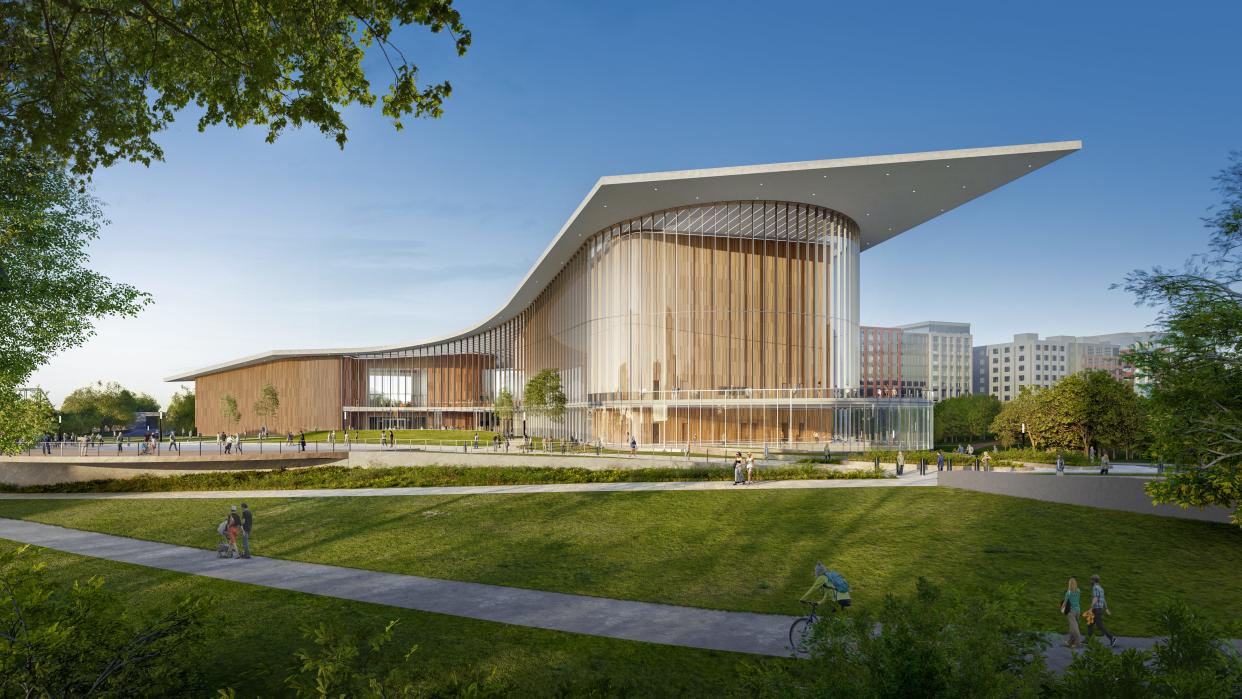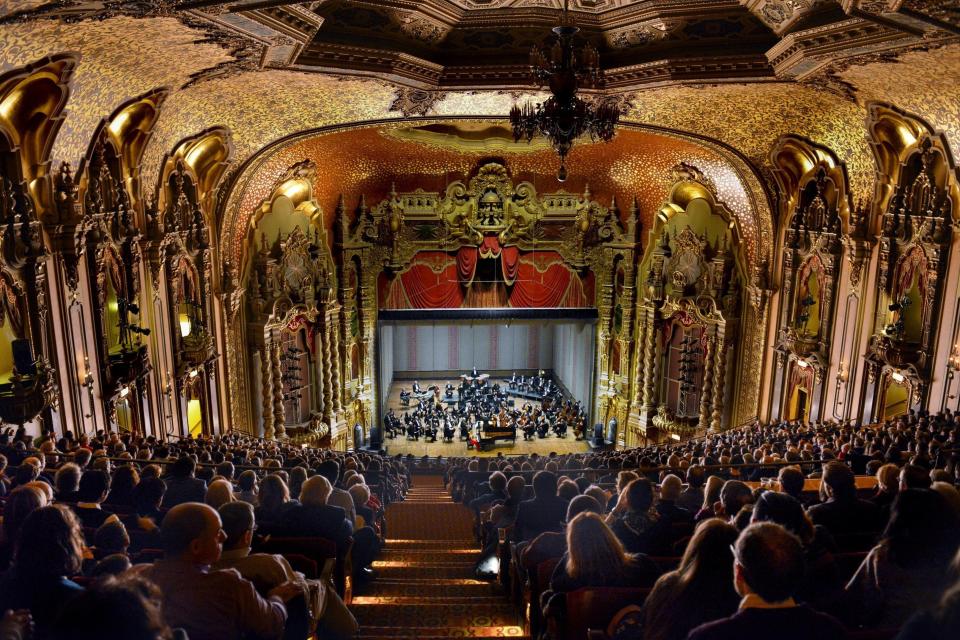How will new Columbus Symphony music hall affect the Ohio Theatre, other arts groups?

Call it a symphonic sea change.
This week, the Columbus Symphony revealed one of the most ambitious undertakings in its 73-year history: a plan to relocate from its longtime home of the Ohio Theatre to a new concert hall to be constructed on a site near the Scioto River.
The 205,000-square-foot proposed venue, to cost $275 million, is described by symphony leaders as the realization of decades of dreaming.
“The symphony has been talking about this for 40 years, but we never were in a position to do anything,” said symphony executive director Denise Rehg. “It was a hope and a dream. (For) about the last 10 years, it became apparent that this wasn’t a hope or a dream anymore. . . . It’s a necessity.”

From the symphony’s perspective, the need for a new space is related to two ongoing challenges in its present home.
First, leaders say, the acoustic requirements of the symphony have never been met by the Ohio Theatre, which was built in 1928 as a Loew’s movie palace.
“The best acoustical possibility for music is not actually represented in the current (theater) assets the community has,” Rehg said.
Second, the symphony must compete for booking with other local groups and national touring shows that also perform at the Ohio Theatre.
“The reality is that there is only so much time to go around,” Rehg said.
The plans — which call for the new concert hall to be financed through private and public money and to open in 2028 — have been greeted with excitement by a number of local arts leaders.

“Growth in the arts community is a good thing,” said Chad Whittington, the CEO of the Columbus Association for the Performing Arts (CAPA), which owns and operates the Ohio Theatre and other performance venues, including the Southern and Lincoln theatres. For many years, the symphony has also tapped CAPA for managerial or back-office services.
“There’s no doubt in my mind that arts, culture and entertainment are going to have to grow to meet the needs of the community,” Whittington said.
Symphony musicians also express great hopes about the new complex, which will be tailored to the symphony but is designed to include nine additional spaces that could be used by other groups or organizations.
“The city of Columbus deserves a new concert hall for its orchestra so that they can realize what a priceless gem they have in that orchestra,” said Betsy Sturdevant, the symphony’s longtime principal bassoonist.
“Also, the Columbus Symphony is seeing to it that the entire community is served by the multifaceted concept of the new hall, which focuses not only on classical music but on all of the cultural needs of the community,” she said.
But, as with any undertaking of such scale and cost, questions remain about the project itself and its impact on the area arts community.
Deep ties to the Ohio Theatre
The symphony has made its home in the Ohio Theatre since 1970, just a year after the theater’s averted demolition thanks to the intervention of local civic leaders.
Through its years at the Ohio Theatre, the symphony has evolved artistically and seen the arrival and departure of numerous notable music directors, from Evan Whallon to Alessandro Siciliani. Its current music director is Rossen Milanov.
More: Columbus Symphony pitching massive $275 million music hall near COSI
While at the Ohio, the symphony also pulled through its lowest point: In 2008, labor disagreements and financial problems within the organization led to a temporary shutdown of operations. CAPA then took charge of many facets of the organization, including its back-office operations.
Over the past decade, the symphony has come to rely less and less on CAPA.
“(Once) it was fair to say that the symphony was really dependent on CAPA for much of the staffing and even the staff leadership needs, and that’s no longer the case,” said Whittington, adding that the two organizations still share some services and staffing.
“That’s certainly a product of a lot of (symphony) board members, a lot of staff for the symphony doing great work over the last decade to bring them well away from where they were in terms of financial stability and operating stability,” he said.
About four years ago, symphony leaders embarked in earnest for a new home — which did not come as a surprise to Whittington.

“Everybody thinks about the symphony and the Ohio Theatre, and they’re closely matched together,” he said. “A hall that’s the right size for them and acoustically suited for them (would be) great if we can make it happen and if it’s right for the community.”
A new concert hall takes shape
Among the $275 million it will take to make the new venue a reality, $37 million has been committed to the project — $10 million from the state of Ohio and $27 million from private donors. The majority of the latter figure comes from just a handful of private individuals.
“I’ve got several gifts of six figures, I’ve got several gifts of five figures and then I have a couple of very major gifts,” said Rehg, adding that she was not authorized to identify the donors or the specific amounts they gave.
“It wasn’t driven by somebody giving us the money,” Rehg said. “People were driven to give us the money because they thought the argument was so strong.”
If all goes according to plan, the main performance area designed for the symphony will seat 1,600 people.
“The 1,600 seat selection (number) was chosen after close and lengthy examination of all the pieces,” said Rehg, who considers the Ohio Theatre’s capacity — about 2,800 seats — too large for a symphony.
Added Whittington: “I can’t think of an example of another symphony around the country that is playing in a 2,800-seat hall or is doing so by choice.”
More: Columbus Symphony Orchestra's $275 million music hall plans - what we know
The symphony says that other groups, activities and programs will be essential to the new venue.
“It won’t only be for us,” Rehg said. “The symphony will use about 20 weeks out of the year; the hall has 52 weeks.”
Prospects for the Ohio Theatre
CAPA officials say they are prepared to add programing at the Ohio Theatre in the symphony’s absence.
“From the very beginning, we’ve said that CAPA will figure out how to fill the hole that’s left at the Ohio,” Whittington said. “I’m confident that we can do that (through) expanding the Broadway series, BalletMet getting some more time in the Ohio, bringing in some more rental (shows).”
One possibility, he said, was to lengthen the run of Broadway in Columbus productions.
“We will explore the idea of going to two weeks of every subscription show for the Broadway season,” Whittington said.
More: Columbus Symphony announces $275 million music hall initiative
CAPA will lose revenue generation by charging the symphony rental fees for use of the Ohio Theatre. But, Whittington added, that shortfall might not be as dramatic as expected: Because CAPA considers the symphony to be a “resident group,” it charges highly competitive rental rates that are about 60% of what would be charged to an outside group.
“As long as we can bring back into the theater more Broadway or more ballet . . . then we will offset that,” said Whittington, who does not anticipate any economic impact on CAPA’s ability to maintain the Ohio Theatre and other historic venues.
Even after it is installed at its new concert hall, the symphony also plans to continue to present pops programming in the Ohio Theatre; those concerts typically draw larger crowds that could justify being held at the Ohio. The Picnic With the Pops summertime series would also remain at the John F. Wolfe Columbus Commons, located directly behind the theater.
“I will still think of the symphony as a resident group, even if they’re only playing at the Ohio four times of year,” Whittington said.
The symphony also hopes that CAPA will help manage the new concert hall, though the precise nature of their involvement remains unclear.
Local arts leaders react
Also unclear is the wider impact of a new performing-arts space that is being spearheaded and designed by a specific performing-arts group — namely, the symphony.
Although the symphony stresses the multiuse nature of the proposed venue, several outside arts leaders said they have not been involved in discussions relating to the project.
“We have not been part of any of the discussion — who’s going to use it, how will it be managed, what programming, who gets priority,” said Janet Chen, the CEO of the ProMusica Chamber Orchestra. “I think those are a lot of legitimate questions.”

Chen expresses enthusiasm about the idea of the concert hall but uncertainty about its particulars.
“If this new hall is intended to serve many arts and community groups — groups of all sizes, operationally, budgetarily — then this could be a very exciting thing for Columbus,” Chen said. “But I do think it will need a lot of input and community dialogue from everyone who would benefit from the space.”
Sue Porter, the executive director of BalletMet, says that her organization would love to augment its performances in the Ohio Theatre with those in a new theater.
“We absolutely believe that this community does need more theater space, especially a theater in the 1,500- or 1,700-seat range,” Porter said. “That’s a perfect size for people who want to watch ballet.”
But, she said, BalletMet has not been part of plans relating to the new venue.
“We’re always excited when the community might want to invest more in the arts,” Porter said. “As far as this particular project, I really don’t know a whole lot about it. We have not been involved in the planning of any of this. I think it’s really too soon to have a specific opinion on it.”
It seems clear that demand exists among some local groups to utilize a new space.
“The beautiful thing about jazz is that it’s so flexible,” said Katy Coy, the CEO of Jazz Arts Group. “Certainly if it’s a multiuse space, . . .we would love to talk to the symphony about potentially performing there.”
Looking ahead
Doug Kridler, the president and CEO of the Columbus Foundation, said that he applauds the ambition behind the project.
“The prospect of a dynamic performing-arts presence on the riverfront is great, and it will take many to rally to make it come to fruition,” said Kridler, also a former president of CAPA. “Possible design images and aspirational announcements are important, but, there is a lot of work to do before we can celebrate this milestone in the evolution of the arts in Columbus. Inspiration is 10% of the game when undertaking something like this; 90% will be perspiration — in planning, fundraising and programming,” Kridler said via email.
For their part, symphony leaders acknowledge that the process of making the new theater a reality is just the beginning.
“Do I feel confident that we have all the numbers just right and in just the right categories?” Rehg said. “It’s going to be hard to say. We have a plan; we haven’t tested the plan.”
This article originally appeared on The Columbus Dispatch: Columbus arts leaders react to proposed $275 million symphony hall
